 Written by Brittany Ferri, OTR/L
Written by Brittany Ferri, OTR/L
The bathroom can be one of the most challenging places for individuals with disabilities to navigate. This process can be even more complicated for individuals with obesity or mobility impairments. Research shows that 75% of nursing facility staff report a lack of equipment as one of the main barriers to caring for individuals with bariatric needs. Many healthcare facilities don’t have the bariatric equipment needed to accommodate this population and may have difficulty properly serving them.
Thankfully, there is a range of bariatric bathroom equipment to help obese individuals who struggle to get around safely and efficiently. No matter what bathroom-related concern you have, there is a piece of bariatric adaptive equipment that can help you.
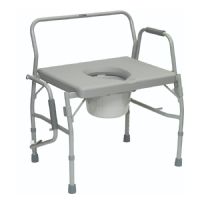 | Bariatric Drop-Arm Commode with 650 lbs View Product |
The bariatric commode is a piece of equipment that obese individuals can use as a supplement or substitute for a traditional toilet. Individuals can sit on the raised seat of a bariatric commode that is mounted above a toilet or placed in a more convenient location for them to use. A bariatric commode has four stable legs and grab bars on either side to allow obese individuals an easier time getting up and down from the seat. Bariatric commodes are not only extra wide but can also accommodate 300 to 1,000 pounds. These bariatric models offer nearly three times the support as a standard commode, which has an upper limit of 300 pounds.
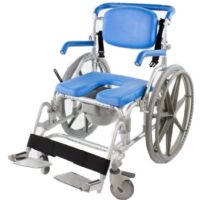 | MaxiBathe 3-in-1 Bariatric Shower Commode Chair by Platinum Health View Product |
Studies show that the level of showering assistance obese individuals need increases from 55% to 65% when their body mass index (BMI) goes from 49 to over 50. When individuals have trouble standing up for long periods or lose their balance in the shower, it is often recommended they get a shower chair. Individuals with obesity can benefit from bariatric shower chairs that allow them to wash their entire body from a seated position. These chairs also offer back support, which is helpful for those with spinal injuries or poor core strength. Bariatric shower chairs look similar to standard shower chairs but are wider and offer much greater weight capacity. Bariatric shower chairs can handle up to 550 pounds compared to standard shower chairs that hold individuals weighing between 350 and 400 pounds.
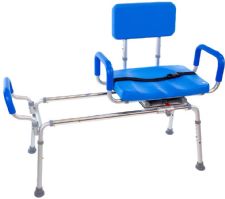 | Carousel Bariatric Transfer Bench by Platinum Health View Product |
A bariatric transfer bench is another type of seating that is useful in the shower. This chair is more suitable for people with sufficient core strength since it does not have a back like standard chairs. A tub transfer bench allows someone to sit on the edge, scoot across and over the lip of the tub, and position themselves in the middle of the space where they will shower. For this reason, someone with an upper body injury might struggle with a tub transfer bench. Benches are naturally wide, so this caters to individuals with obesity. Bariatric tub benches have the added benefit of a greater weight capacity and can handle up to 500 pounds.
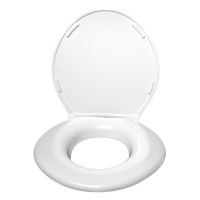 | Big John Bariatric Toilet Seat View Product |
It is not uncommon for individuals living with obesity to need more support from their existing fixtures. However, this doesn’t always mean they require specific equipment. Some individuals can benefit from bariatric toilet seats, which operate the same way as a standard toilet seat but with added reinforcements. Bariatric toilet seats come in standard widths and have grips that allow them to stay close to the toilet. This type of toilet seat is known to support up to 1,200 pounds.
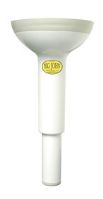 | Big John Toilet Support View Product |
Individuals with obesity may feel uneasy using a wall-mounted toilet, which is why their bariatric bathroom equipment may be more straightforward than others. Sometimes the best equipment for an obese individual is a toilet support that acts as one sturdy leg placed directly below the bowl. While other individuals might also opt for toilet support for their wall-hanging toilets, they will not have the same weight capacity. The bariatric toilet support increases a toilet’s weight capacity to 1,000 pounds and even tightens up the fixture to prevent potential leaks.
Obese individuals who don’t need as much support as a commode offers or simply prefer not to use one can opt for the bariatric raised toilet seat. This equipment is securely installed under a standard toilet seat to give individuals several inches of added height. The bariatric raised toilet seat can handle up to 600 pounds and even keeps an individual’s hygiene needs in mind with a removable front part to help with wiping.
 | HealthCraft P.T. Hinged Rail View Product |
Research shows that individuals with moderate to severe obesity are more likely to require assistance from two people when navigating the toilet and shower. Since extra body weight can make a person unsteady on their feet, grab bars can help! Grab bars come in all shapes and sizes and truly cater to each person’s needs. There are grab poles, rails, small grab bars, adjustable length rods, and more that all come with varying weight capacities. Individuals with obesity might have trouble getting around and changing positions, so anyone looking into grab bars should carefully evaluate the weight capacity of each style. Wall-mounted grab bars are considered the most reliable and have a weight capacity of between 300 and 500 pounds. Such a weight capacity is typically ideal for individuals with obesity since they don’t require someone to put their weight on the bar.
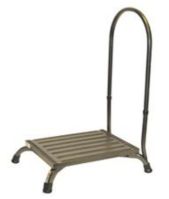 | ConvaQuip Bariatric 1000lb Weight Capacity Step Stool with Handle View Product |
Anyone of short stature can attest to how useful step stools are. This equipment is versatile and can be used anywhere in the home to help people access hard-to-reach places. Bariatric step stools offer the same convenience and level of assistance but are built of steel and made to handle loads of up to 1,000 pounds. This style of bariatric step stool also gives users a long, curved handle to offer added stability to the upper body, which is something not all step stools have.
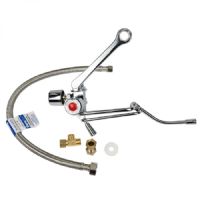 | Bidematic Bidet Attachment - Non-Electric by Performance Health View Product |
Bidets are another example of equipment that isn’t exclusively for those with medical concerns but can help individuals with obesity or mobility difficulties. A bidet is a pressure-activated tool that offers a gentle, effective stream of water to clean the perineal area. Bidets are more economical since they lower toilet paper use but can also help maintain hygiene and skin integrity. Bidets are especially helpful for people who have difficulty reaching awkward places or stretching their upper body without losing balance.
Most bariatric bathroom equipment can handle between 500 and 1,000 pounds, but there is no standard range. Anyone looking to buy bariatric bathroom equipment should not assume the weight capacity of a product is sufficient for them just because it’s labeled bariatric. If your weight is on the higher end of any given range, look for a product with a higher weight capacity just to be sure. Read labels, ask questions, and double-check the weight capacity to ensure your satisfaction and safety.
Individuals looking for bariatric bathroom equipment might also have vision concerns that prevent them from safely using their aids. For this reason, the finish and color should play a part when someone is looking for bathroom equipment. Many bathrooms have white fixtures such as toilets, sinks, and tubs. If vision is an issue for you, it’s best to get a piece of equipment that will stand out from the white you already have. The contrast will help you find (and use) the product more efficiently. There are many pieces of bathroom equipment that are blue and gray for this reason.
This equipment might not need to be moved as often as mobility equipment such as walkers, but there may be instances where you must adjust for cleaning, company visiting, and more.
Not all bariatric bathroom equipment is seating, so width is not always relevant. However, if you are getting a product like a tub bench or shower chair, check the specifications to ensure the seat width can accommodate you. Just as with weight capacity, not all products labeled bariatric will have an adjusted seat width – most are standard. So rereading the description for this figure will go a long way when choosing a product.
There are several features to consider when looking for bariatric bathroom equipment. Users should always look for the item’s portability, seat width, color (if vision is a concern), and weight capacity before purchasing anything. If you are having trouble in the bathroom but aren’t sure what product is best for you, look into our product recommendations for more information.
For more products, check out all of our bariatric adaptive equipment. If you want more information on similar topics, check out our Caregiver University blog for more articles.

Brittany is an occupational therapist who has worked in a variety of rehab facilities. She has always expressed an interest in patients’ internal motivation for therapy and the use of assistive devices, which led her to pursue a PhD in Integrative Mental Health. This research-based training has also led her to develop her writing career to educate patients of all ages on how to improve their health. Brittany has published four books, written over 300 articles, and has been quoted in media outlets such as WebMD, Healthline, and NBC News.